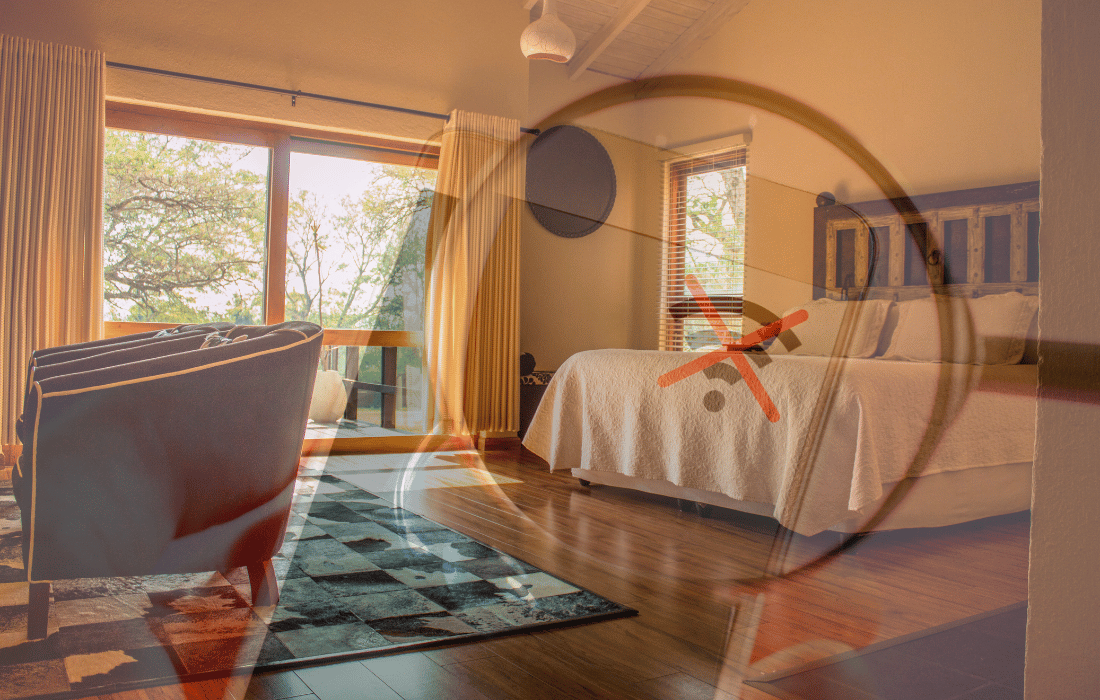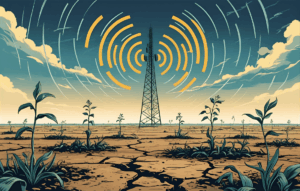In a world that thrives on connectivity, the modern traveler is increasingly looking for ways to unplug—both from their devices and from the invisible forces of electromagnetic fields (EMFs) that surround them. While health-conscious travelers have long sought out eco-friendly accommodations and allergen-free environments, a growing niche is prioritizing low-EMF or EMF-free Airbnbs and vacation rentals. This shift comes in response to rising concerns about the health effects of prolonged EMF exposure and the increasing number of individuals reporting sensitivities to wireless technology.
For travelers seeking a complete break from the invisible stressors of modern life, the demand for low-EMF accommodations is more than just a trend—it’s becoming a key part of their wellness routine. But what exactly is driving this movement, and how can both hosts and travelers navigate the challenges of reducing EMF exposure in an increasingly wired world?
Why Are People Seeking Low-EMF Accommodations?
The average person is exposed to electromagnetic radiation nearly every waking moment—whether from their smartphones, laptops, Wi-Fi routers, or even the smart meters in their homes. While most individuals don’t notice these invisible forces, a growing number of people, particularly those who identify as having electromagnetic hypersensitivity (EHS), are finding that even short-term exposure to EMFs can trigger a host of uncomfortable symptoms.
EMF sensitivity can manifest in various ways, including headaches, fatigue, insomnia, dizziness, and difficulty concentrating. For these individuals, finding an environment that minimizes EMF exposure is critical to their comfort and well-being. However, EMF concerns are no longer limited to this niche group. As more studies suggest potential links between EMF exposure and long-term health effects—such as oxidative stress, nervous system dysregulation, and even an increased risk of certain cancers—wellness-conscious travelers are taking note.
The wellness movement has evolved to include more than just organic food and yoga retreats. Many travelers now view their vacation time as an opportunity for a full-body reset, which means paying attention to all aspects of their environment—including the EMF levels in their surroundings. With growing awareness, these travelers are seeking accommodations that support their desire to rest, recover, and detox from the stressors of modern life.
Several factors are fueling this rise in demand for low-EMF vacation rentals:
Increased Awareness of EMF Health Impacts: As research into EMFs and their biological effects grows, more people are becoming aware of the potential risks associated with long-term exposure. This awareness is spreading particularly fast among the biohacking and holistic wellness communities.
The Rise of Digital Detox Vacations: The concept of a digital detox vacation is gaining traction, as people seek to escape the constant connectivity of their daily lives. For many, this now includes not just avoiding their screens, but also retreating from the Wi-Fi and cell towers that emit EMFs.
The Expansion of Wellness Tourism: Wellness tourism is a rapidly growing segment of the travel industry, with travelers seeking accommodations that support their health and well-being. Low-EMF environments offer a natural extension to the eco-friendly and toxin-free accommodations that are already popular among this group.
Anxiety About Urban Living: As cities become more saturated with wireless technology, many individuals feel overwhelmed by the invisible electromagnetic smog that surrounds them. Rural and remote properties are becoming increasingly appealing, offering a sanctuary from the high-density EMF pollution found in urban areas.
What Makes a Property “Low-EMF”?
For a property to be truly considered “low-EMF” or “EMF-free,” it must limit or eliminate the main sources of electromagnetic radiation. This can be achieved through a combination of technology choices, construction materials, and geographical location. The following are key features that differentiate a low-EMF property from a typical vacation rental:
Wired Internet Over Wi-Fi: One of the most significant sources of EMF exposure in a modern home is wireless internet. Low-EMF properties typically offer wired internet connections, allowing guests to stay connected without the constant exposure to Wi-Fi signals. Some properties may even forgo internet altogether for a complete digital detox.
Minimal Smart Devices: Smart homes are convenient but come with the downside of emitting significant levels of EMF radiation. Low-EMF properties avoid or minimize the use of smart devices, opting for traditional thermostats, appliances, and lighting systems that don’t rely on wireless connectivity.
Remote Locations: Properties located far from cell towers and other high-EMF areas naturally offer a more low-EMF environment. This is especially appealing to travelers who are looking to reconnect with nature while minimizing their exposure to man-made radiation.
EMF Mitigation Technologies: In addition to reducing EMF exposure through passive means, some properties actively employ EMF mitigation technologies, such as Aires Tech devices, which are designed to neutralize the harmful effects of electromagnetic radiation.
Aires Tech: Enhancing Low-EMF Travel Experiences

As awareness of EMF exposure grows, travelers and property owners alike are turning to EMF mitigation technologies to create safer, more balanced environments. Aires Tech has emerged as a leader in this space, offering scientifically-backed solutions for reducing the harmful effects of EMF radiation. For travelers seeking a low-EMF experience, Aires Tech devices provide an added layer of protection, ensuring that their environment is as EMF-free as possible—even when completely avoiding EMF sources isn’t feasible.
Here’s how Aires Tech can enhance both the traveler and host experience:
Portable Protection: Aires Tech devices, such as the Lifetune Flex, are portable and easy to use, making them ideal for travelers who want to protect themselves from EMFs while on the go. Guests can bring these devices along with them, offering protection even in accommodations where Wi-Fi or other EMF sources are present.
Home Integration for Hosts: For Airbnb hosts looking to cater to the growing market of EMF-sensitive travelers, installing Aires Tech devices in their properties can make their listings more appealing. These devices help neutralize EMF radiation, creating a safer and more comfortable environment for guests.
Scientific Backing: Aires Tech’s effectiveness is supported by decades of transparent research, making it a trusted solution for reducing the negative impacts of EMF exposure. For wellness-conscious travelers, this provides peace of mind, knowing they are taking proactive steps to protect their health.
The Lack of Low-EMF Filters on Airbnb
Despite the growing demand for low-EMF accommodations, platforms like Airbnb have yet to provide standardized filters or categories for such listings. While guests can search for properties that are eco-friendly or non-smoking, finding low-EMF accommodations requires significant legwork. Travelers must often contact hosts directly to inquire about Wi-Fi, smart meters, or nearby cell towers—information that is not typically included in the property description.
This gap in the market presents a significant opportunity for Airbnb to cater to the wellness-conscious traveler. By introducing an “EMF-free” or “low-EMF” filter, the platform could make it easier for travelers to find accommodations that align with their health goals.
What Airbnb could do to embrace the low-EMF trend:
Develop a Dedicated Filter: Airbnb could create a filter specifically for low-EMF or EMF-free properties, similar to its existing filters for eco-friendly or allergen-free accommodations.
Encourage Transparency: Hosts could be encouraged to provide detailed information about EMF sources and mitigation measures on their property listings. This would make it easier for travelers to make informed decisions about where to stay.
Expand Wellness Categories: The wellness travel market is growing rapidly, and expanding Airbnb’s eco-conscious categories to include EMF-free options would allow the platform to stay ahead of the curve.
How to Find and Choose Low-EMF Accommodations
For travelers seeking low-EMF vacation rentals, the process often involves a bit of extra research. Here are some practical steps to take when searching for an EMF-conscious accommodation:
Look for Remote Locations: Properties in rural or isolated areas are generally better for those seeking a low-EMF environment, as they are farther from urban cell towers and dense wireless networks.
Contact Hosts Directly: Before booking, reach out to the host and ask specific questions about EMF sources. Inquire about Wi-Fi usage, smart devices, and the proximity of cell towers. Some hosts may be willing to accommodate special requests, such as turning off Wi-Fi during your stay.
Use Aires Tech Products: Bringing along a portable Aires Tech device can help protect you from EMF exposure, even in environments where some EMFs are present. This allows you to enjoy your vacation without constantly worrying about radiation levels.
Consider Alternative Platforms: In addition to Airbnb, there are niche platforms and websites that specialize in eco-friendly and low-EMF accommodations. These sites often cater specifically to travelers looking for toxin-free and low-radiation environments.
The Future of Wellness Travel: EMF-Free Accommodations
As the wellness tourism market continues to expand, the demand for low-EMF accommodations will likely follow suit. Travelers are becoming more discerning about the environments they choose to stay in, prioritizing health, relaxation, and a sense of well-being. While Airbnb and other major platforms have yet to catch up with this trend, the increasing awareness around EMFs suggests that it’s only a matter of time before low-EMF accommodations become a standard offering.
By providing low-EMF environments, property owners can tap into a growing niche of travelers who value holistic well-being and want to protect themselves from the stressors of modern life. Likewise, companies like Aires Tech are playing a crucial role in shaping the future of wellness travel by offering solutions that allow people to minimize EMF exposure no matter where they are.
Conclusion: A Healthier Way to Travel
As concerns about EMF exposure continue to rise, the demand for low-EMF accommodations is set to become a key feature of the wellness travel market. Whether you’re a traveler looking to minimize your EMF exposure or a property owner wanting to appeal to health-conscious guests, the future of travel lies in creating spaces that promote balance, relaxation, and well-being.
Integrating tools like Aires Tech’s EMF protection devices can make a significant difference, offering peace of mind to both hosts and guests. As wellness tourism continues to evolve, those who embrace these changes will be at the forefront of a healthier, more conscious way to travel.














